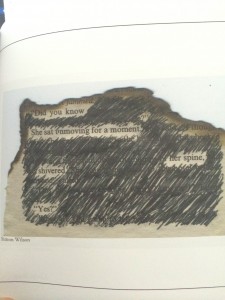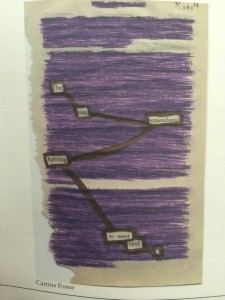My uncle works for a printing company in Rochester and contacted me one day, asking if I’d like some copies of literary and art magazines from Monroe Community College. I gladly accepted, curious as to what nearby colleges are up to with their poetry.
Cabbages & Kings displays a collection of visual art, interviews and poems, but they also included blackout poetry in the 2012 issue. However, in the 2013 and 2014 issues I have, no blackout poetry had been published. I wanted to know what you guys, poetry blog perusers, thought about blackout poetry as a craft, as a challenging prompt, as a useful tool, or just in general.
Is destruction just another form of creation—Would Donnie Darko support blackout poetry? Or is it not usually done well enough to be worth the time and effort of scribbling out a page in a book? Maybe this is to say something about black space as opposed to white space. Perhaps we can try it ourselves. For now, let’s take a look at some of Cabbages & Kings‘s stuff:



I can’t remember how it happened, but sometime last semester I got erasure/blackout poetry fever. I never ended up making one, I’ll have to add that to the list of poetry things that I haven’t done and must do now.
Anyway, the two texts I’ve spent the most time with are Radi Os by Ronald Johnson, an erasure poem created from the first four books of Paradise Lost, andA Humument by Tom Phillips. With Johnson’s poem the only visual aspect is the space that remains after the erasure. The original spacing is kept as if Johnson took a huge eraser to the text.
Phillips is a visual artist by trade, his book presents pages that are much closer to these blackouts, although I think calling them “collage-outs” or “paint-outs” would be more accurate. He applies his treatment to an entire novel from the Victorian era that had faded into obscurity. You can flip through it on the book’s website. Even after flipping through it for months I’m not sure if all of the pages add up to something like they would have in the actual novel, but each of the pages is a functioning whole, and when the visual aspects really work with the text they can be masterpieces. The way he call to attention the white space that appears between text we would normal see as a block, and the way that informs the visual and text aspects of the page, was the most exciting technique I noticed.